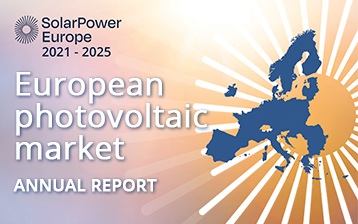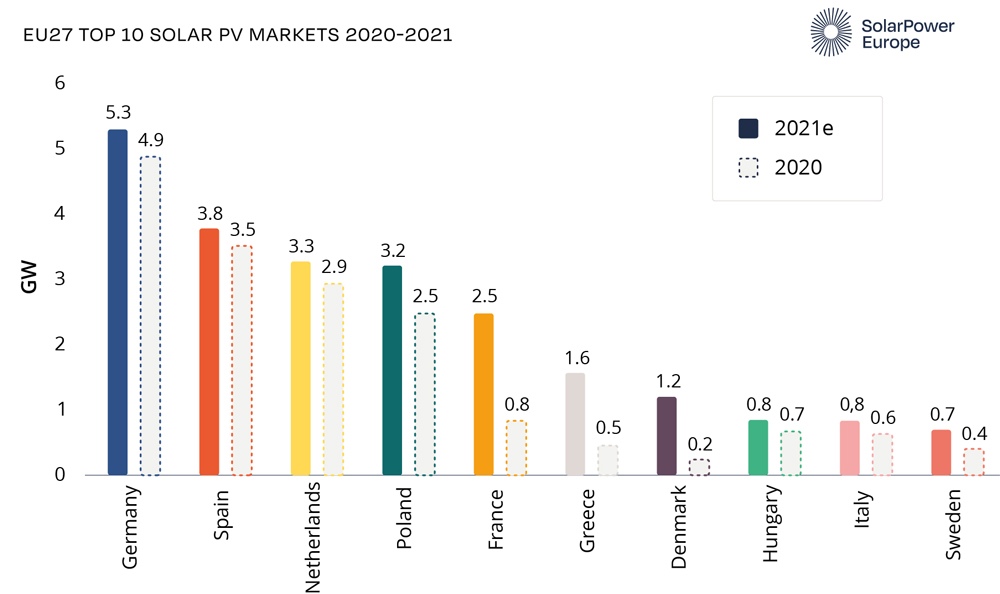Also this year the EU Market Outlook for Solar Power 2021-2025 was published by SolarPower Europe (2021), that is the annual update on the forecasts of the European PV market for the next 4 years with the usual with consolidated installation data, in this case of 2021.
SolarPower Europe aggregates over 260 associations in the solar field and has been studying the PV sector for many years and for some years also the storage sector, to provide all market players with historical and statistical data as well as making market forecasts.
25.9 GW installed in Europe in 2021
According to the EU Market Outlook for Solar Power 2021-2025, 2021 was the best year ever for installations in the European Union with about 25.9 GW, to return to installed powers above 20 GW you have to go back by 10 years, in 2011, where Italy with its Conto Energia subsidy had made a large contribution to reach 21.4 GW specifically.
These nearly 26 GW are 34% more than in 2020 which had registered 19.3 GW of installations.
165 GW of total photovoltaic systems installed in Europe
Consolidated photovoltaic installations across Europe now reaches about 165 GW, about half of these PV systems are installed in only two countries: Germany and Italy, where the first has an almost triple power compared to our country considering 59.9 GW compared to ours 22 GW.
If you go to see this data in 2020 Italy and Germany represented over 55%, this tells us that last year there were very strong markets compared to ours since Germany is confirmed as the country with the greatest power connected to the grid of the EU.
Top 10 countries divided by annual installation
The top 5 countries for installations remained the same, in the ranking of the top 10, two new entry both from the North: Denmark and Sweden, in seventh and tenth place respectively, which displaced Belgium and Portugal from the ranking.
All the top 10 finishers increased their annual installations, and in the top seven countries, installations exceeded the GW.
1st Germany
Germany has always been first in this ranking, this year with 5.3 GW, 8% more than 4.9 GW of the last year.
In 2021 there was a slowdown in growth, just under half a GW, while between 2017 and 2020 there were always increases above the GW.
In any case, this shows to the rest of Europe as a legislative mixed scheme where there are diversified incentives for medium-large commercial plants and utility scales as well as having a population with a strong “green thinking” can be the key to achieving the objectives set by the European Commission for 2030.
2nd Spain
The second place is occupied by Spain, 3.8 GW compared to 3.5 GW in 2020. Most of the installed is made up of utility scale plants, making it one of the first PV markets in the world without subsidies, but makes it clear how rapid growth is linked to the grid network since the 2.9 GW of power allocated in two auctions in 2021 will only be able to be connected in 2023.
Spain also dedicated part of the Recovery Plan to the energy transaction with 450 million euros that will be allocated to small self-consumption residential systems.
3rd Netherlands
The Netherlands remains in third place with 3.3 GW, 11% more from 2.9 GW in 2020.
The main market is the commercial field with about 40% of the installations, the residential with the on-site exchange subsidy about 30% of the installed power, while the large ground systems for about the remaining 20%.
For commercial and utility scale plants, the Dutch government uses a tender scheme within the SDE++ program to incentivize their installation and this program helped build a 187 MW PV plant last year, the largest in the country.
4th Poland
Not far behind as installed power in 2021, but off the podium we find Poland with 3.2 GW but with a very high growth rate, of 28% compared to last year.
This is an excellent result considering that it is only since last year that Poland exceeds the GW of installations.
These exceptional performances are the result of an incentive scheme that favors self-consumption for prosumers, which allows for reductions in VAT and taxes.
In addition, an auction program for systems above the MW is active which in June ’21 assigned 1.2 GW of power to PV compared to the 0.3 GW awarded to wind power, for example.
5th France
In fifth place we find France with 2.5 GW, the first year above GW but above all a market that has more than tripled compared to around 800 MW in 2020.
The French regulatory framework support large plants with tenders for ground and roof systems above 500 kW, while the residential sector of prosumers is very limited.
To date, France has about 12 GW in cumulative power, and aims to reach 20 GW in 2023, to then become 44 GW by 2028.
6th and 7th Greece and Denmark
Sixth and seventh place are Greece and Denmark, the last states in Europe to have above the GW in 2021.
Greece with around 1.6 GW has more than tripled compared to the 500 MW of 2 years ago, while Denmark has made an exceptional performance considering the 200 MW in 2020 compared to 1.2 GW last year.
Greece’s result is attributable to small projects below 500 kW incentivized with a feed-in tariff system that has been extended until 2022.
Denmark, on the other hand, has reached this extraordinary level of growth thanks to ground-based systems without incentives, while the residential market born about 10 years ago, thanks to incentives, today occupies a negligible percentage of the market as well as commercial systems.
It should be noted that Denmark has the highest growth rate in the 27 countries belonging to the European Union.
8th, 9th, 10th Hungary Italy, Sweden
The last 3 country of the Top 10 have installations under the GW and roughly equal, Hungary and Italy about 800 MW, while Sweden 0.7 GW, however all three of these countries have had more installations than in 2020.
In Italy, the bulk of the result is due to the incentive scheme with 110% Tax Bonus (Superbonus 110%) which is dedicated to residential installations, this same incentive has allowed Italy to emerge further in the storage market, while bureaucratic complications they do not favor large installations on the ground through the rod mechanism.
For Hungary, on the other hand, it was the small ground systems and rooftop installations up to 50 kW that contributed to this result. In December 2021, a new incentive scheme was born, financed by the European Union energy transition fund.
Lastly, the new entry in Sweden where state subsidies fuel the demand which has almost doubled from around 400 MW to 700 MW in 2021.







